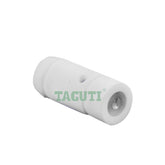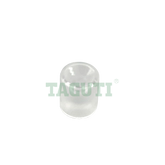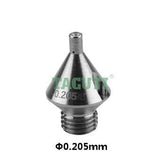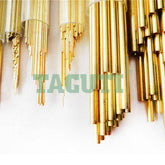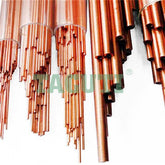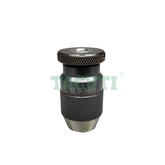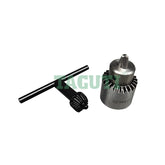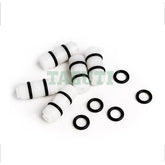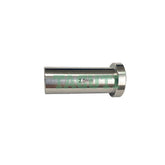Technical Analysis of Threaded Electrodes for EDM
As one of the core technologies in the field of precision manufacturing- electrical discharge machining (EDM), it's threaded electrode components play an irreplaceable role in the processing of complex structures. We systematically expand and elaborate on the technical details and application value of threaded electrodes from multiple dimensions such as material science, structural design, application practice, performance optimization, and supply chain system.
A. Material types and properties
The material selection of threaded electrodes directly affects the processing efficiency and accuracy. The types of materials commonly used in modern EDM include:
1. Copper thread electrodes
Materials: Mainly copper (oxygen-free copper), with a conductivity of up to 98% IACS and excellent processing stability. Suitable for medium and low precision thread processing with low cost.
Process: The cold extrusion process is used to improve the compactness of the material, reduce internal pores, and enhance the ability to resist arc erosion. The cold extrusion process extrudes the material under low temperature conditions to arrange the material particles more closely, thereby improving its compactness. This process effectively reduces the tiny pores inside the material, which may become erosion points of the arc during high-temperature discharge machining. In addition, the cold extrusion process can also improve the hardness and strength of the material, making it more resistant to the high temperature and high pressure generated by the arc.
Application scenarios: Suitable for thread cavity processing of ordinary steel, aluminum and other materials, widely used in mold manufacturing.
2. Silver tungsten alloy thread electrodes
Materials: The high conductivity of silver (62% IACS) combined with the high melting point of tungsten (3422°C) form a high-temperature arc resistance and high-strength structure.
Application scenarios: The silver content (10-30%) is controlled through powder metallurgy process to balance conductivity and mechanical strength, suitable for high-precision and heavy-load processing.
3. Tungsten copper thread electrodes
Materials: Tungsten skeleton provides hardness (HV≥1300), copper matrix ensures conductivity (≥60% IACS), suitable for precision molding of hard materials (such as cemented carbide).
Process: High temperature sintering and heating isostatic pressing is used to solve the tungsten-copper interface bonding problem and avoid delamination failure;
Application scenarios: Blind hole thread processing (below M1.2) of micro medical devices (such as artificial joints).
4. Special alloy thread electrodes
Beryllium cobalt copper thread electrode: Beryllium strengthens the elastic modulus and is suitable for high-frequency vibration processing environment; cobalt element improves anti-oxidation performance.
Silver-nickel-copper alloy: Improves welding performance by adding nickel, making it easier to repair and reprocess electrodes.
Nanocomposites: Add carbon nanotubes or alumina particles to improve wear resistance and thermal conductivity uniformity.
B. Design standards
The structural design of threaded electrodes must take into account mechanical strength, cooling efficiency and processing accuracy.
1. Thread parameters
Multi-standard compatibility: In addition to ISO/ANSI standards, it supports customization of international standards such as DIN and BS, and the pitch accuracy can reach ±0.002mm.
Non-standard design: For special-shaped threads (such as trapezoidal threads and left-hand threads), we adopt 3D modeling + CNC machining integrated design.
Edge strengthening: The thread top is chamfered (0.1-0.3mm) to reduce stress concentration and improve the durability and service life of the thread electrode.During the EDM process, optimizing parameters such as chamfer angle and depth can further enhance the edge strength and reduce wear.
2. Cooling channel innovation
Micropore array design: A cooling channel with a diameter of 0.3-0.8mm is arranged inside the electrode to achieve directional cooling of the discharge area and reduce thermal deformation.
Spiral flow channel structure: The coolant flows in a spiral along the thread axis to enhance flushing efficiency and discharge erosion particles.
Gas-liquid two-phase cooling: Introducing high-pressure gas assistance, suitable for chip removal problems in deep hole processing.
3. Surface engineering enhancement
Upgrade of plating technology: the thickness of the silver plating layer is controlled at 2-5μm to reduce the surface resistance; the nickel plating layer improves the wear resistance and is suitable for processing high hardness materials.
Surface roughness control: Use mirror polishing technology (Ra≤0.4μm) to reduce discharge micro cracks.
Coating materials: PVD coatings such as TiN and CrN, which are resistant to high temperatures and adhesive wear.
C. Common application scenarios
Threaded electrodes are widely used in high-precision manufacturing fields, including:
1. Precision mold manufacturing
Injection mold thread cavity: fine thread (M8×0.75) of PET preform mold, precision requirement IT6, electrode reuse times ≥50 times.
Twill structure of stamping die: The twill core-pulling structure of automobile cover die realizes three-dimensional thread forming through electrode rotation processing.
2. Forming of difficult-to-process materials
Carbide thread processing: When processing blind hole threads (M6×1) of YG20C materials, the use of tungsten-copper composite electrodes improves processing efficiency by 40% compared to traditional electrodes by optimizing current parameters and adopting internal cooling methods. The high conductivity and corrosion resistance of tungsten-copper composite materials effectively reduce processing time.
Titanium alloy thin-walled parts: The cooling hole threads (diameter Φ2.5) of aircraft engine blades are processed without burrs by using micro-electrodes.
3. Micro precision structure
Medical devices: The micro-thread (M0.8×0.2) of orthopedic screws has an electrode diameter of only 0.3mm, and is used in conjunction with micro-EDM machines to achieve sub-micron precision.
Optical instruments: Precision threads (pitch 0.1mm) of camera lens adjustment mechanisms, using silver-tungsten alloy electrodes to ensure surface finish.
D. Loss processing comparison
Verify the core performance of threaded electrodes through comparative experiments:
Compare the loss rate of copper electrode and silver-tungsten alloy electrode in processing H13 mold steel: the loss rate of the former is 0.35%, while that of the latter is reduced to 0.12%.
Processing time: Silver-tungsten alloy electrode has a 20% increase in efficiency under the same parameters
E. Selection technical standards
1. Material adaptation
Hard materials (hardness ≥ HRC60) are preferably tungsten copper/silver tungsten alloy;
Silver-plated electrodes are recommended for mirror processing, and the surface roughness can reach Ra0.2μm.
2. Precision control
Precision: The electrode manufacturing tolerance must be controlled within 1/3 of the workpiece tolerance;
Deep hole processing: electrode diameter tolerance ±0.002mm, straightness ≤0.001mm/100mm.
3. Process compatibility
Machine tool requirements: spindle runout ≤ 0.003mm, servo system resolution 0.1μm;
Discharge fluid selection: Kerosene-based working fluid is suitable for high-precision processing, and deionized water is suitable for scenarios with environmental protection requirements.
F. Threaded electrode maintenance and life extension
1. Wear detection
Measure the change in thread electrode diameter regularly (e.g. once every 10 hours of processing) and replace it when the wear exceeds 0.05mm.
Use eddy current flaw detector to detect surface cracks, find micro cracks in time and prevent sudden fractures.
2. Regenerative repair
Remelting and reprocessing of worn electrodes: Recycling of waste electrode materials and restoring their performance through vacuum melting technology.
Surface coating repair: First, clean the surface of the slightly worn electrode to ensure that it is free of oil and impurities; then use physical vapor deposition (PVD) technology to deposit a wear-resistant coating on the electrode surface. During the repair process, the coating thickness and temperature must be controlled to extend the electrode life by 30%.
3. Operating instructions
To ensure the clamping accuracy, the coaxiality between the electrode and the machine tool fixture should be ≤0.005mm;
Strengthen coolant management, filter impurities regularly, and control the pH value of the coolant between 7 and 8.
G. Conclusion
The threaded electrode technology for EDM is developing in the direction of composite materials, functional structures and intelligent manufacturing. From microscopic material design to macroscopic process integration, its technological breakthroughs continue to push the boundaries of precision manufacturing. Scientific selection, optimized design and standardized maintenance will help companies achieve efficient and high-precision threaded structure processing and provide solid technical support for high-end equipment manufacturing.
EDM Drilling Consumables
- from $18.00
- from $18.00
- Unit price
- / per
- from $0.00
- from $0.00
- Unit price
- / per
- $4.95
- $4.95
- Unit price
- / per
- $1.99
- $1.99
- Unit price
- / per
- from $0.00
- from $0.00
- Unit price
- / per
- $6.99
- $6.99
- Unit price
- / per
- $4.99
- $4.99
- Unit price
- / per
- $49.99
- $49.99
- Unit price
- / per
- from $6.99
- from $6.99
- Unit price
- / per
- $0.99
- $0.99
- Unit price
- / per
- $1.99
- $1.99
- Unit price
- / per
- $1.99
- $1.99
- Unit price
- / per
- $18.00
- $18.00
- Unit price
- / per
